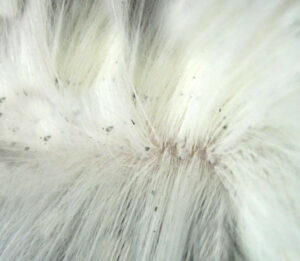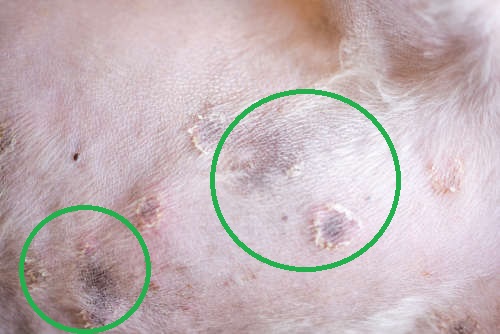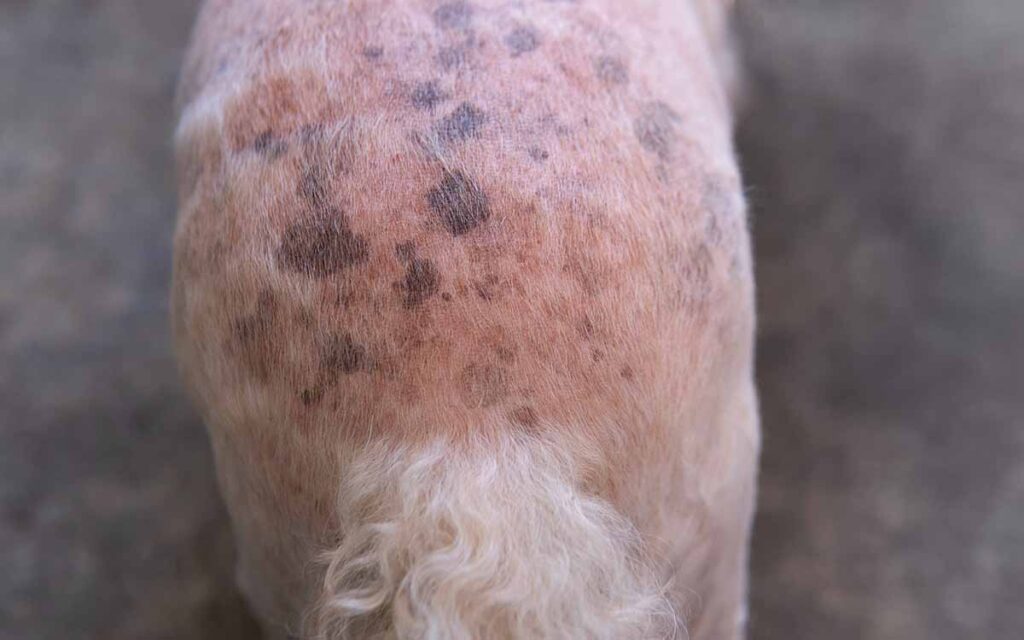
This article was updated on December 15th, 2023

One condition we commonly see in our veterinary practice is discolored, dark or black spots on the skin. The good news is that these black spots are usually benign. In some cases, however, they can be a sign that your dog has an underlying health problem such as a skin infection or an allergy.
7 things you should know about black spots on your dog’s skin:
In this article, our dermatologist Dr. Ian Spiegel & veterinarian director Dr. Jamie Whittenburg share 7 tips for dealing with black spots:
1. Black spots may just be age spots or macules, which are not a concern if the skin otherwise looks normal
Below is a picture of normal black skin on the belly of a 5-year-old dog. These age spots are usually nothing to worry about:

“If the darkened areas are 1) flat, 2) mild and 3) slowly darkening to black, with no change to the texture of the skin, it is likely that the dog has benign age spots. This can be a normal part of the aging process.”
Below is another picture showing normal age spots:

Dogs may also have natural black spots or patches on their skin. These spots are called macules or patches. The 2 pictures below show black spots as a normal part of the dog’s skin coloration:

If the spots are black and loose on your dog’s hair and skin, it could also be fleas or flea excrement, as shown below. Your number one clue that your dog has fleas is that they will likely chew, lick or scratch themselves more than usual.

2. Black spots need veterinary treatment if they are itchy or accompanied by other signs such as hair loss or red skin
“Dark spots are a reason for concern when the affected skin also changes texture or becomes itchy. When the skin becomes black, as well as itchy, red, rough or scaly, your dog likely needs veterinary treatment.”
Thus, you should call your vet if your dog’s skin is:
- Itchy: A dog will show they are itchy by scratching, licking or chewing at their skin. Read more about Itchy Black Spots.
- Red around the area: In the picture below, dark spots on this Shih Tzu can be seen with a red rash:

- Rough, scaly, or crusty
- Thickened (lichenification): This occurs when dogs have an overgrowth of yeast on their skin and the result can be what many owners refer to as “elephant skin“, as shown on the picture below:

Photo example of black spots requiring veterinary treatment
The picture below shows a dog with dark black patches, as well as other signs of disease including redness, hair loss, and a rough skin appearance. All these signs combined definitely indicate that this dog needs veterinary treatment:

3. Allergies, parasites and skin infections are common causes of black spots on a dog’s skin
Dark spots, along with the other signs of redness, scaling, crusting, and itchiness, are most commonly a result of the following medical conditions:
1. Allergies
Up to 20% of dogs develop allergies in their lifetime. Allergies resulting in black spots will typically be accompanied by:
- Itching
- Red skin
- Excessive licking/grooming
The black spots will be flat and not raised off the skin’s surface, as shown in the picture below.
Learn more about Skin Issues Due to Allergies.

2. Parasites (fleas and ticks)
Parasites, such as fleas and ticks, will typically cause itching as well as biting of the skin. The parasites themselves are often visible on the pet. These dark spots, like allergy spots, will be flat on the skin.
Learn more about Skin Flea Allergies and Mites.


Photo: © Ian Brett Spiegel VMD, MHS, DACVD
3. Injuries/trauma
Any irritation or injury (e.g., self-induced from scratching, post-vaccine/needle, burns, etc.) to either the skin, or even the underlying bones, joints, and muscles, can result in hyperpigmentation & dark spots. Typically, these black spots will also be flat on the skin’s surface and will be over or near the injury.
Upon closer inspection, it is common for these spots to be scabs or darker spots that are a result of the skin’s healing. Because they are due to a break in the skin’s barrier, these dark spots will shrink and then usually disappear with time.
Click here to see dark spots on skin as a result of a burn (warning: graphic image).


Photo: © Ian Brett Spiegel VMD, MHS, DACVD
4. Bacterial skin infections
Skin infections are very common in dogs: according to Banfield Pet Hospitals, skin infections are one of the top 5 reasons for veterinarian visits. Skin infections can lead to skin irritation and black spots. These spots will lie flat as part of the skin and will not have a mass-like appearance.
Bacterial skin infections (usually Staphylococcus sp.) cause black spots on the skin in the same manner as injuries: the infection ends up damaging the skin’s barrier, as shown on the picture below.
Learn more about Bacterial Skin Infections.

5. Yeast skin infections
Yeast infections (Malassezia sp.) are the most common type of fungal infection in dogs. They typically present as:
- Itchiness
- Red and inflamed skin
- Black spots
- Thickening of the skin (if a yeast infection is left untreated)



Photo: © Ian Brett Spiegel VMD, MHS, DACVD
The dog’s immune system response to the yeast overgrowth can lead to increased production of melanin, the pigment that gives skin its color. This protective response can lead to darkening on the skin.
Learn more about Black Spots from Yeast Infections.
6. Autoimmune diseases
Autoimmune disorders occur when the body’s defense mechanisms overreact and attack part of the body thinking it is a foreign invader. If the condition involves the skin, the result can be hair loss, lack of pigmentation, or hyperpigmentation as the body attacks cells in the skin. With proper treatment, these spots should be resolved.

Photo: © Ian Brett Spiegel VMD, MHS, DACVD
The symptoms of autoimmune diseases in dogs vary widely depending on the type of disorder, but often include lethargy, weakness and loss of appetite.
Learn more about Autoimmune diseases.
7. Comedones (blackheads)
Comedones are what we often refer to as blackheads. These occur when the hair follicle becomes blocked with bacteria, dead skin cells, dirt, and oils. Blackheads can be secondary to other skin conditions or a stand-alone issue.
See this picture of comedones on Animal Allergy Colorado or the picture below:

Photo: © Ian Brett Spiegel VMD, MHS, DACVD
Comedones are pores or hair follicles that have gotten blocked with bacteria, oil (sebum), and dead skin cells (keratin) to form bumps on the skin. They are not inflamed or painful.
9. Hormone changes
Rarely, a hormone change due to aging or sterilization surgery (spay or neuter), can cause areas of the skin to become darker. This may also occur with some endocrine diseases such as hypothyroidism, hyperadrenocorticism, and diabetes. With hyperadrenocorticism, calcium can build-up under the skin (calcinosis cutis). This can also happen from corticosteroids administered at high doses.

Photo: © Ian Brett Spiegel VMD, MHS, DACVD

These changes are benign and will not be raised, scaly, or itchy. The most common place to see this is trunk of the dog.

If you suspect (or know) that your dog is dealing with hormone changes, there are two conditions worth noting: cyclical flank alopecia and alopecia X. You can read about these conditions and see more pictures in this article: Cyclical Flank Alopecia and Alopecia X.
10. Other conditions leading to skin irritation and itching
Food allergies, mange, and other disorders can all lead to skin irritation that may result in hyperpigmentation and black spots or black patches on a dog’s skin. As hyperpigmentation results from chronic irritation, these spots will lie flat as part of the skin and will not have a mass-like appearance.
4. Spots on the belly are usually normal but could be a sign of an underlying condition
“Black spots on a dog’s belly can be perfectly normal. Some dogs are born with dark spots on the skin as a normal part of their skin coloring. Others tend to develop dark spots on their bellies as they age.”
The pictures below show two examples of normal black spots or normal dark areas on a dog’s belly:


However, there is a possibility that black spots on a dog’s belly are a sign of an underlying condition such as skin infection, allergies, endocrine disease, or even cancer, so newly noticed spots should always be brought to the attention of the dog’s veterinarian.
5. Black spots near the mouth can be a sign of malignant melanoma (cancer of the melanocytes in the skin)
Dark or black spots on a dog’s skin can be an indication of a cancer termed melanoma. These skin masses may be malignant (cancerous and apt to spread) or benign. These are cancers of the melanocytes in the skin that produce melanin. Though not the case 100% of the time, malignant melanomas most commonly occur in the mouth, around the lips, or on the gums.
Learn more about Melanomas or Black Lumps on Dogs.


Any changes in your dog’s skin should be brought to the attention of your dog’s veterinarian immediately. In many cases, prompt treatment of the underlying cause will cure both the cause and resolve the hyperpigmentation.
6. To treat black spots on your dog, a veterinarian must first diagnose and address the underlying cause
The first step in treatment is diagnosing the underlying cause. This process can be aided by examining the dog’s skin as well as obtaining a thorough medical history. Any itching, licking, parasites, or injuries should be noted.
- Skin infections, whether bacterial or fungal, must be identified and treated.
- Many dogs with these skin ailments also have underlying skin allergies, either to something in the environment or food allergies, and these must be controlled. Allergies in dogs are just like allergies in people—they cannot be cured. However, they can be managed.
- Endocrine disorders, such as hyperadrenocorticism (Cushing’s Disease) and hypothyroidism, are also lifelong health issues that need to be treated and controlled. These illnesses, if left untreated, will have significant adverse effects on the dog’s health and will drastically shorten their life span.
- Malignant melanomas are aggressive tumors and need to be removed surgically. Many cases will require post-surgical cancer care, including chemotherapy, immunomodulation, or radiation.
7. Preventing black spots is difficult, but treating allergies or infections and limiting sun exposure can help
Due to the many varying causes of hyperpigmentation in dogs, prevention is difficult. Owners should always treat any allergies, infection, or injuries to the skin promptly and continue treatments as necessary.
“UV damage may also play a role in hyperpigmentation, so it is prudent to keep dogs out of the sun as much as possible and when not, to utilize dog-safe sunscreen such as zinc oxide on non-haired areas of skin.”
Frequently asked questions
Why does a dog’s skin turn black?
The most common causes include allergies, parasites, and inflammation (e.g., trauma/injury, bacterial or fungal infections). There are other causes, including:
- Aging
- Specific breed characteristics (e.g., Black Labradors, Scottish Terriers, etc.)
- Endocrine disorders:
- Hypothyroidism
- Cushing’s disease (hyperadrenocorticism)
- Diabetes
- Estrogen-producing tumors (Sertoli cell – testicular)
- Medications (e.g., corticosteroids – oral or topical)
- External environment changes (UV light exposure)
- Cancer
What is hyperpigmentation?
Most instances of dark or black colored spots on the skin of dogs are hyperpigmentation. As previously mentioned, hyperpigmentation is the medical term used to describe an increase of the pigmentation on a dog’s skin when the amount of color is more than what is normal for that dog. Hyperpigmentation in dogs is usually more of a symptom than a disease in and of itself.
What does it mean if my dog has black spots that are itchy?
Black spots, or areas of hyperpigmentation, will not cause your dog to itch. It is more likely that your dog has another condition, such as a food or environmental allergy, or parasites, that is causing them to be itchy. The spots could also be the result of the same condition.
Read our article about itchy black spots in dogs.
What does it mean if my dog has black spots near her privates?
Black spots near a dog’s genitals have the same causes as black spots in other areas. If the skin’s appearance is changing suddenly and if the dog is licking that area, it is essential to determine the underlying cause. It could have something to do with their urinary or reproductive tracts. The genitals often have skin folds and are also frequently moist, and are ideal places for a skin infection to arise.
Can a dog yeast infection cause black or dark spots?
Yes, yeast infections of the skin can result in black spots. This is due to the chronic irritation of the skin from itching, licking, and the organism living on the skin. Most dogs with yeast skin infections happen as a result of allergies. It is imperative to not only treat the skin infection but also to address and control the allergies to prevent a recurrence.
Related Posts
- Brown Spots on the Skin: Veterinarian Advice with Pictures.
- Spots on a Dog’s Belly: What Do They Mean?
- Pictures of Common Skin Conditions in Dogs.
Disclaimer: This website's content is not a substitute for veterinary care. Always consult with your veterinarian for healthcare decisions. Read More.




Be the first to comment